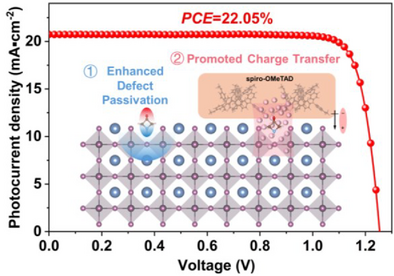Fluorination-Assisted Interfacial Dipole for CsPbI3 Perovskite Solar Cells with Over 22% Efficiency
Graphical Abstract
Fluorination-assisted interfacial dipole engineering is conducted for inorganic CsPbI3 PSCs, which could not only form more robust interfacial contact but also beneficial dipole alignment, leading to effective passivation and prominent energy level adjustment with additional charge transport channels, thus substantially suppressing interfacial energy losses. Consequently, the PSCs show an efficiency of up to 22.05% with superior device stability.
Abstract
Inorganic CsPbI3 perovskite attracts widespread attention in photovoltaic applications due to its superior thermal stability and optoelectronic properties. However, CsPbI3 perovskite solar cells (PSCs) still suffer from severe energy losses due to interface nonradiative recombination and undesirable charge carrier transfer, predominantly limiting their photovoltaic performance. Herein, an interfacial dipole engineering is introduced for CsPbI3 PSCs, in which azetidinium chloride (Az) and its fluorinated derivative 3,3-difluoroazetidinium chloride (DFAz) are employed to manipulate the interface properties of PSCs and thus diminish energy losses. Systematically theoretical calculations and experimental studies reveal that the fluorination-assisted ammonium molecule could form a stronger interaction with perovskites and thereby arrange the dipole alignment on the superficial layer of perovskites, which could simultaneously ameliorate the passivation effect and energy level alignment of the perovskite and hole transport layers, thereby suppressing interface recombination. Meanwhile, the coordinated bonding between the ammonium and hole transport layer facilitates charge transfer at the heterojunction interface by offering additional carrier transport channels. Consequently, the CsPbI3 PSCs deliver a high efficiency of up to 22.05%. This work provides important design principles of interface engineering for high-performance solar cells to minimize energy losses.
Conflict of Interests
The authors declare no conflict of interest.
Open Research
Data Availability Statement
The data that support the findings of this study are available from the corresponding author upon reasonable request.





